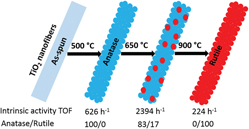Crossref Citations
This article has been cited by the following publications. This list is generated based on data provided by
Crossref.
Li, Yuxin
Fu, Rong
Wang, Xiangdong
and
Guo, Xiaoling
2018.
Preparation of core–shell nanostructured black nano-TiO2 by sol–gel method combined with Mg reduction.
Journal of Materials Research,
Vol. 33,
Issue. 24,
p.
4173.
Manju, Janoha
and
Joseph Jawhar, Soosai Michael
2018.
Synthesis of magnesium-doped TiO2 photoelectrodes for dye-sensitized solar cell applications by solvothermal microwave irradiation method.
Journal of Materials Research,
Vol. 33,
Issue. 11,
p.
1534.
Mahto, Madhusudan Kr.
Samanta, Dipanjan
Konar, Suraj
Kalita, Himani
and
Pathak, Amita
2018.
N, S doped carbon dots—Plasmonic Au nanocomposites for visible-light photocatalytic reduction of nitroaromatics.
Journal of Materials Research,
Vol. 33,
Issue. 23,
p.
3906.
Pascariu, Petronela
Airinei, Anton
Iacomi, Felicia
Bucur, Stefan
and
Suchea, Mirela Petruta
2019.
Functional Nanostructured Interfaces for Environmental and Biomedical Applications.
p.
307.
Yan, Xuehua
Yuan, Xiaoxue
Wang, Jinging
Wang, Qiong
Zhou, Chen
Wang, Dongfeng
Tang, Hua
Pan, Jianmei
and
Cheng, Xiaonong
2019.
Construction of novel ternary dual Z-scheme Ag3VO4/C3N4/reduced TiO2 composite with excellent visible-light photodegradation activity.
Journal of Materials Research,
Vol. 34,
Issue. 12,
p.
2024.
Yu, Chengtao
Zhang, Jingyi
Yang, Hexu
Zhang, Ling
and
Gao, Yu
2019.
Enhanced photovoltaic conversion efficiency of a dye-sensitized solar cell based on TiO2 nanoparticle/nanorod array composites.
Journal of Materials Research,
Vol. 34,
Issue. 07,
p.
1155.
Zhang, Hongnan
Yu, Ming
and
Qin, Xiaohong
2019.
Photocatalytic Activity of TiO2 Nanofibers: The Surface Crystalline Phase Matters.
Nanomaterials,
Vol. 9,
Issue. 4,
p.
535.
Song, Chan‐Geun
Won, Jonghan
Jang, Inhoon
and
Choi, Hyeunseok
2021.
Fabrication of high‐efficiency anatase TiO2 photocatalysts using electrospinning with ultra‐violet treatment.
Journal of the American Ceramic Society,
Vol. 104,
Issue. 9,
p.
4398.
Dejpasand, Mohamad Taghi
Saievar-Iranizad, Esmaiel
and
Bayat, Amir
2021.
Photoluminescence enhancement of single-layer graphene quantum dots by the surface plasmon resonance of Au nanocubes.
Journal of Luminescence,
Vol. 236,
Issue. ,
p.
118070.
Che Hak, C R
Ridzuwan, S
Zainal Abidin, S S
Saidin, N U
and
Ahmad Fuzi, S A
2021.
Effect of electron irradiation to the photocatalytic activity of the titanium dioxide fibers.
IOP Conference Series: Materials Science and Engineering,
Vol. 1106,
Issue. 1,
p.
012016.
Cano-Casanova, L.
Amorós-Pérez, A.
Ouzzine, M.
Román-Martínez, M.C.
and
Lillo-Ródenas, M.A.
2021.
Enhancement of the TiO2 photoactivity for propene oxidation by carbon incorporation using saccharose in hydrothermal synthesis.
Journal of Environmental Chemical Engineering,
Vol. 9,
Issue. 1,
p.
104941.
Diaz-Uribe, Carlos
Duran, Freider
Vallejo, William
Puello, Esneyder
Zarate, Ximena
and
Schott, Eduardo
2023.
Photocatalytic study of TiO2 thin films modified with Anderson-type polyoxometalates (Cr, Co and Ni): Experimental and DFT study.
Polyhedron,
Vol. 231,
Issue. ,
p.
116253.
Guo, Li
Ji, Cheng
Wang, Haiwang
Ma, Tianxiao
and
Qi, Jian
2024.
Design and construction of high strength double network hydrogel with flow-induced orientation.
Journal of Colloid and Interface Science,
Vol. 672,
Issue. ,
p.
497.
Abid, Mahmoud
Howayek, Tia Maria
Mazur, Olga
Viter, Roman
Bekheet, Maged F.
Nada, Amr A.
Bezzerga, Djamel
Hong, Jisang
Miele, Philippe
Iatsunskyi, Igor
Coy, Emerson
Lesage, Geoffroy
Habchi, Roland
Cornu, David
and
Bechelany, Mikhael
2025.
Innovative electrospinning approach to fabricate TiO2/NiO nanofibers for effective acetaminophen degradation.
Colloids and Surfaces A: Physicochemical and Engineering Aspects,
Vol. 709,
Issue. ,
p.
136077.




